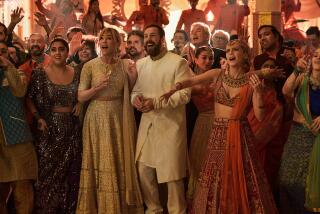Violence, risky behavior a common mix in big films, study says
A medical journal that recently concluded that violence in PG-13 movies is skyrocketing has a new report showing that almost 90% of the highest-grossing recent movies have violent characters, more than three-quarters of which also engage in drinking, smoking or sex.
The study in Pediatrics, the monthly publication of the American Academy of Pediatrics, focused on the on-screen combination of violence and other conduct that the researchers say makes violence look âas acceptable as these other behaviors.â The study also found that the mixture of violence and at least one other ârisk behaviorâ such as alcohol or tobacco use was nearly as common in films rated PG-13 as it was in movies rated R.
Although the new study, being released Monday, did not reach any fresh conclusions about how audiences might be affected by the cinematic mixture of risky conduct, its authors reiterated that earlier investigations had shown that some consumers could and did emulate on-screen behavior.
SPECIAL REPORT: The culture of violence
âWeâre interested in how adolescents view these films,â Daniel Romer of the Annenberg Public Policy Center at the University of Pennsylvania said. âWe know that some adolescents will initiate alcohol use, some adolescents will initiate tobacco use and some adolescents will initiate sexâ based on what they see in entertainment.
Romer and two other researchers at the university analyzed behavior of characters in 390 of the most popular films in the United States from 1985 to 2010.
Mirroring the report in Pediatrics a month ago, which found that gunplay in PG-13 releases had tripled in fewer than 30 years and that PG-13 titles were now more violent than R-rated movies, the new study found that violence was ubiquitous in Hollywood blockbusters, with 89.7% of those 390 movies having at least one scene of violence.
More troubling to the researchers, characters that behaved violently in 77.4% of those 390 films also engaged in at least one other behavior considered dangerous for children and adolescents, primarily alcohol use or sex, which happened alongside violence about 62% of the time. About half of those conjoined behaviors were immediately proximate, happening in the same five-minute window.
PHOTOS: Billion-dollar movie club
Romer and the researchers called this the âJames Bond effect,â wherein violence is glamorized by pairing it with other risky conduct, or shown as acceptable as sex. The researchers cited a scene in Brad Pitt and Angelina Jolieâs âMr. & Mrs. Smithâ as an example of a film depicting violence and sex as equally acceptable.
âWe are concerned that these are shown as normal adult behaviors,â Romer said.
Films rated PG-13 were almost as likely to depict violence alongside at least one other risky behavior as were R-rated movies; 81.7% of PG-13 films included such a link versus 87.7% for R-rated titles.
On one positive note, the researchers concluded that tobacco use in conjunction with violence had dropped steadily, while alcohol use was slightly in decline.
The researchers nevertheless called on the Motion Picture Assn. of America to revisit how it rated films, particularly those deemed so family-friendly that anyone could buy a ticket.
PHOTOS: Holiday movie sneaks 2013
âOur findings also raise serious concerns about the effectiveness of the MPAA rating system for allowing potentially harmful co-occurring content in youth-accessible films,â the report concluded.
In a statement, the MPAA said, âItâs important to remember that a PG-13 is a strong warning to parents about the content of a film, and it is accompanied by a descriptor that gives parents specific detail about which elements of the film warranted the rating.
âThe purpose of the rating system is to reflect the standards of American parents, not set them â the rating board tries to rate a film the way they believe a majority of American parents would rate it. Societal standards change over time and the rating system is built to change with them.â
Twitter: @jghorn
More to Read
Only good movies
Get the Indie Focus newsletter, Mark Olsen's weekly guide to the world of cinema.
You may occasionally receive promotional content from the Los Angeles Times.











